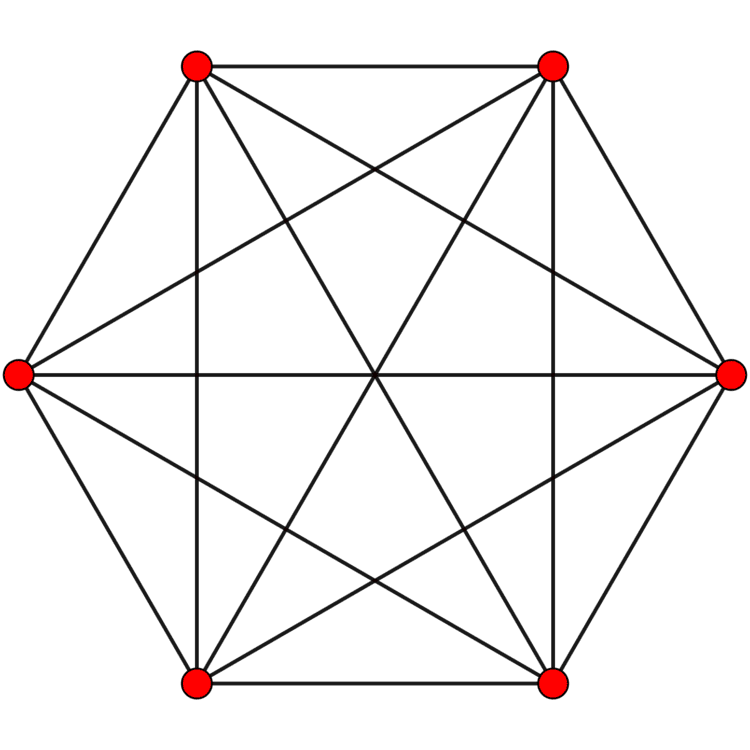 | ||
In five-dimensional geometry, a rectified 5-simplex is a convex uniform 5-polytope, being a rectification of the regular 5-simplex.
Contents
- Rectified 5 simplex
- Alternate names
- Coordinates
- Birectified 5 simplex
- Images
- Construction
- k22 polytopes
- Related uniform 5 polytopes
- References
There are three unique degrees of rectifications, including the zeroth, the 5-simplex itself. Vertices of the rectified 5-simplex are located at the edge-centers of the 5-simplex. Vertices of the birectified 5-simplex are located in the triangular face centers of the 5-simplex.
Rectified 5-simplex
In five dimensional geometry, a rectified 5-simplex, is a uniform 5-polytope with 15 vertices, 60 edges, 80 triangular faces, 45 cells (15 tetrahedral, and 30 octahedral), and 12 4-faces (6 5-cell and 6 rectified 5-cells). It is also called 03,1 for its branching Coxeter-Dynkin diagram, shown as .
E. L. Elte identified it in 1912 as a semiregular polytope, labeling it as S1
5.
The rectified 5-simplex, 031, is second in a dimensional series of uniform polytopes, expressed by Coxeter as 13k series. The fifth figure is a Euclidean honeycomb, 331, and the final is a noncompact hyperbolic honeycomb, 431. Each progressive uniform polytope is constructed from the previous as its vertex figure.
Alternate names
Coordinates
The vertices of the rectified 5-simplex can be more simply positioned on a hyperplane in 6-space as permutations of (0,0,0,0,1,1) or (0,0,1,1,1,1). These construction can be seen as facets of the rectified 6-orthoplex or birectified 6-cube respectively.
Birectified 5-simplex
The birectified 5-simplex is isotopic, with all 12 of its facets as rectified 5-cells. It has 20 vertices, 90 edges, 120 triangular faces, 60 cells (30 tetrahedral, and 30 octahedral).
E. L. Elte identified it in 1912 as a semiregular polytope, labeling it as S2
5.
It is also called 02,2 for its branching Coxeter-Dynkin diagram, shown as . It is seen in the vertex figure of the 6-dimensional 122, .
Alternate names
Images
The A5 projection has an identical appearance to Metatron's Cube.
Construction
The birectified 5-simplex is the intersection of two regular 5-simplexes in dual configuration. The vertices of a birectification exist at the center of the faces of the original polytope(s). This intersection is analogous to the 3D stellated octahedron, seen as a compound of two regular tetrahedra and intersected in a central octahedron, while that is a first rectification where vertices are at the center of the original edges.
It is also the intersection of a 6-cube with the hyperplane that bisects the 6-cube's long diagonal orthogonally. In this sense it is the 5-dimensional analog of the regular hexagon, octahedron, and bitruncated 5-cell. This characterization yields simple coordinates for the vertices of a birectified 5-simplex in 6-space: the 20 distinct permutations of (1,1,1,−1,−1,−1).
The vertices of the birectified 5-simplex can also be positioned on a hyperplane in 6-space as permutations of (0,0,0,1,1,1). This construction can be seen as facets of the birectified 6-orthoplex.
k_22 polytopes
The birectified 5-simplex, 022, is second in a dimensional series of uniform polytopes, expressed by Coxeter as k22 series. The birectified 5-simplex is the vertex figure for the third, the 122. The fourth figure is a Euclidean honeycomb, 222, and the final is a noncompact hyperbolic honeycomb, 322. Each progressive uniform polytope is constructed from the previous as its vertex figure.
Related uniform 5-polytopes
This polytope is the vertex figure of the 6-demicube, and the edge figure of the uniform 231 polytope.
It is also one of 19 uniform polytera based on the [3,3,3,3] Coxeter group, all shown here in A5 Coxeter plane orthographic projections. (Vertices are colored by projection overlap order, red, orange, yellow, green, cyan, blue, purple having progressively more vertices)
